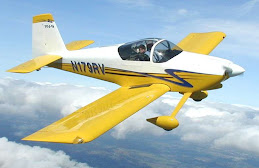I included the Vans training project with the order for my empennage and yesterday, having declared the workshop finally ready (not "finished", mind you), I got to work on the project at last.
The project has two elements; a section with two plates and an angle that have to be rivetted together and a short section of a mock aerofoil comprising channel section spar, reinforcing plates, ribs at each end, four stiffners, top and bottom skins, which are curved and pop-riveted at the leading edge like a typical rudder and double-flush rivetted through a wedge extrusion at the trailing edge. The whole thing measures about one foot square when finished.
The instruction say "if the finished project ends up with various dents, holes and other fumbles. . . good! It means you haven't been afraid to try and you are making your "beginners mistakes" here instead of on the actual airplane". Well, I'm glad they said that because otherwise, I would be profoundly depressed today. I can't get over how many mistakes I made. Mainly for my own benefit, here's a list of the main ones:
1. Not reading the plans fully. I put all the stiffners in facing outboard, with the result that the top and bottom flanges were meeting when the section was fully assembled. I drilled two of them out and switched them - unacceptable on a flying aerofoil in my view, as they had been match-drilled to different positions on the skin. However, it demonstrated the exactness of the matched hole system as the stiffners sat perfectly in their new positions. I also missed the fact that the reinforcing plates on the spar were to be fastened with size 4 universal head rivets and did not need to be dimpled. I actually resorted to using flat heads in the dimpler to fix this one by flattening out the dimples. I imagined that far away in Aurora, Oregon, a very distinguished kitplane manufacturer was wondering why he had a sudden urge to cringe! Sorry Mr V. On an actual airplane, that would have meant replacing the spar. I also managed to misread the rivet call-out for the first section of the project and put a universal head into a dimpled hole intended and already dimpled for a countersunk head rivet. At least, I am now quite practiced at drilling out rivets and I do not believe I damaged any of the holes while doing this - a skill that will be used extensively, I am beginning to realise.
2. Deburring holes to be dimpled. The Isham inc. 'manual' makes the case that deburring is over emphasised in the homebuilt community. You can see the effect of deburring very clearly on the underside of a dimple because an edge that should be nice and sharp is clearly 'shaved off' when that edge is turned up and formed into the sharp end of a 'funnel', as in a dimple. This robs effective depth from the finished metal. I have decided to look for a gentler way of removing obvious burrs from holes to be dimpled and leave it at that.
3. Bad rivetting. I encountered every sort of problem with rivetting. I have under-driven rivets, over-driven rivets, slanted heads, off-center heads and hardly a universal factory head without a 'smiley' grinning stupidly back at me. I also seem to have let the mushroom set float off two bucked skin rivets, leaving a slight dent in the skin beside the factory heads. Like I said, I am now very experienced in drilling out these offending examples. I don't even know what I did wrong in some cases. As most riveting is done either in the horizontal or vertical planes, I thought of getting tiny spirit levels to glue to the top, side and 'breech' of my gun as a guide to lining up the gun properly until I can judge it better by eye. One fault (slanted heads) was not really my fault. It happens when back rivetting close to stiffners. The white plastic collar on the back rivet set is quite thick and when the angle used for stiffners is small and the holes are close to the web, it prevents the actual head from sitting squarely on top of the shank. As rivetting progresses, it slides off, leaving a head shaped like a ski jump. Holding the collar firmly with my free hand improved things but I think I will grind off a flat section on one side of this collar when I encounter similar small angles in the elevators.
4. Poor drilling. I managed to get an elongated hole in the trailing edge wedge. This happened while using a drilling guide to achieve the correct angle. Maybe I was concentrating too much on the guide.
I didn't have all the materials available (who has mild steep plate, hardwood blocks and bits of 4 X 2 lumber knocking about the place?) so the project is not yet finished. I can see that the bucking/dimpling bar that I am supposed to make from the steel plate will be necessary on every small rib so I will go to the trouble of making it exactly according to plans. I simply improvised the rest.
All in all, it was quite a chastening experience and far from the simple limbering up exercise that I thought it was going to be. Hopefully, it will turn out to be the best $35 that I will spend on the entire project.
Subscribe to:
Post Comments (Atom)


No comments:
Post a Comment